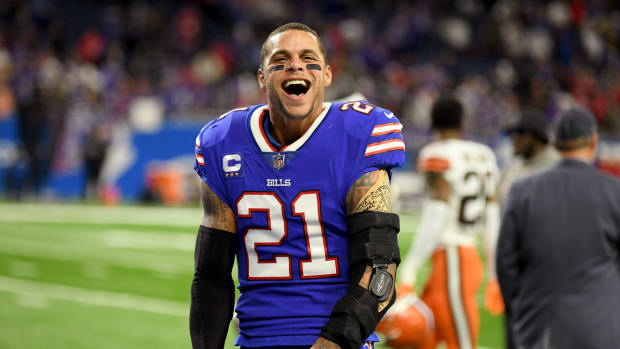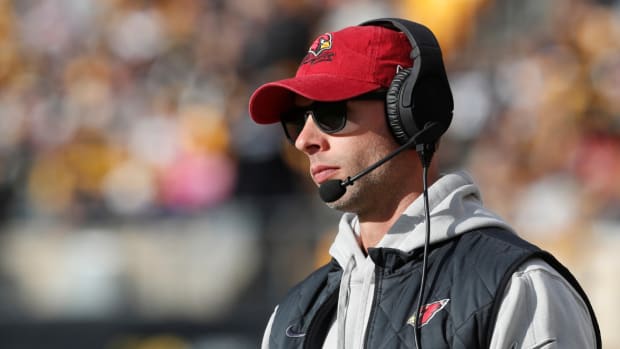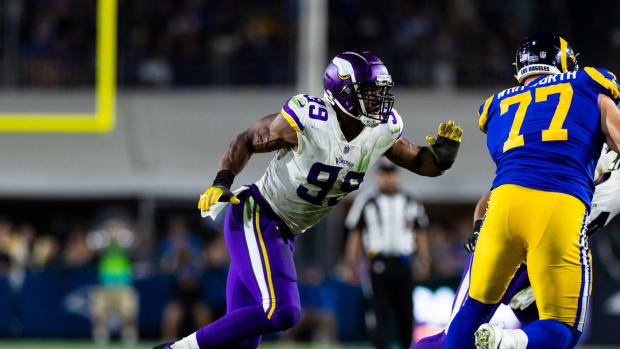How does Tom Brady's 2016 season compare to his other Super Bowl campaigns?
When Tom Brady made his first Super Bowl appearance, he was but a precocious young player, thrust into the difficult position of replacing a long-time franchise staple. Now, he stands, in many minds, as the greatest QB to ever play the game.
Sunday will mark Brady’s seventh Super Bowl trip as New England’s quarterback, spanning 16 years. How did Brady’s 2016 regular-season performance measure up to his previous six Super Bowl seasons? An attempt to rank them in order of how impressive they were, saving the best for last:
2003—Patriots finish 14–2, beat Panthers 32–29 in Super Bowl XXXVIII
(3,620 yards passing, 60.2% completion rate, 23 touchdowns, 12 interceptions, 85.9 QB rating)
As a full-time starter, this season might have been the worst of Brady’s career. If nothing else, it began with the worst game on Brady’s NFL resume: a 31–0 shellacking at Buffalo, in which Brady threw four interceptions and finished with a career-low QB rating of 22.5.
• The annotated version of SI's gamer from the 2004 Super Bowl in Houston
The Patriots lost just one more game during the 2003 season, winning their final 12 plus all three in the playoffs. Brady was very good for much of that regular-season run—three TDs and no picks the week after losing to the Bills; a 350-yard, three-TD performance vs. Denver; eight TDs to no INTs in Weeks 15–17—but he did not consistently dominate like he’s done so many seasons since.
Backing him that year, too, was the league’s top-ranked scoring defense, a group that allowed fewer than 15 points per game and forced 41 turnovers. In five of New England’s 14 regular-season wins, its opponents scored six points or fewer (including three shutouts).
2001—Patriots finish 11–5, beat Rams 20–17 in Super Bowl XXXVI
(3,620 yards passing, 60.2% completion rate, 23 touchdowns, 12 interceptions, 86.5 QB rating)
Was Brady’s 2001 season better than his ’03 season? Statistically, no, at least in most respects. Aside from his rookie season of 2000 and his injury-halted 2008, this was the lone year Brady failed to reach 3,000 yards passing or 20 TDs (he finished with 18, to 12 interceptions). He threw for just 189.6 yards per game and took 41 sacks.
Consider, though, the circumstances. Brady was not meant to be the starter in 2001, but found himself thrust into the spotlight when Drew Bledsoe suffered a Week 2 injury. To that point in his young career, Brady had attempted 10 regular-season passes, all coming in mop-up duty during a 2000 loss to the Lions. In this third start, he threw for 364 yards and two touchdowns to beat San Diego.
The ’01 Patriots did have an offensive balance the ’03 Patriots could not match—Antowain Smith rushed for 1,157 yards and 12 TDs in 2001. But it they also were not the defensive force in ’01 that they were in ’03. While Brady was not yet the Brady we now know, he did as well as anyone could have expected coming off the bench to lead a team that was far from perfect.
Super Bowl LI predictions: SI's NFL experts make their picks for Patriots-Falcons
2004—Patriots finish 14–2, beat Eagles 24–21 in Super Bowl XXXIX
(3,692 yards passing, 60.8% completion rate, 28 touchdowns, 14 interceptions, 92.6 QB rating)
This may have been the season that Brady truly embarked on his path toward being one of the all-time greats. His TD percentage—the frequency with which a pass ends in a touchdown—rose, from 4.4% in 2003 to 5.9%. His yards per completion increased, too, from 6.9 to 7.8. Ditto yards per completion: 11.4 to 12.8. In the first four games of New England’s season (all wins), Brady threw multiple touchdowns passes, and he would do so another seven times before the end of the year.
Brady did have the benefit of RB Corey Dillon’s career-high 1,635 yards rushing, plus a defense that ranked second in scoring and third in turnovers. But Brady also helped elevate what was a rather mundane, if underrated, receiving corps. David Givens (874 yards) enjoyed a career year, followed closely by David Patten (800 yards); Deion Branch (454 yards) landed a distant third. All three averaged at least 13.0 yards per catch.
• Read every Super Bowl gamer ever published by Sports Illustrated
2014—Patriots finish 12–4, beat Seahawks 28–24 in Super Bowl XLIX
(4,109 yards passing, 64.1% completion rate, 33 touchdowns, 9 interceptions, 97.4 QB rating)
Let’s start with the run game. The Patriots actually finished in the middle of the pack on the ground (18th), but their leading rusher for the regular was Jonas Gray with just 412 yards—you might recall that 201 of those yards (and four TDs) happened in one game vs. Indianapolis.
The majority of the offense came via Brady’s right arm. Four different Patriots finished the season with 50-plus catches, led by Julian Edelman (92) and including RB Shane Vereen (52). There also was another 1,152 yards from Rob Gronkowski, by that point operating sans Aaron Hernandez.
Brady actually started ’14 slowly—four TDs to two INTs over Weeks 1-4, as the Patriots opened 2-2. He then cranked out a five-week run with 18 total touchdowns to just one interception.
Tom Brady's decline will come eventually. The question of the Pats' off-season will be: When?
2011—Patriots finish 13–3, lose to Giants 21–17 in Super Bowl XLVI
(5,235 yards passing, 65.6% completion rate, 39 touchdowns, 12 interceptions, 105.6 QB rating)
Had the 2010 Patriots not been stunned by the Jets in the playoffs and instead reached the Super Bowl, that Brady season (36 touchdowns, four interceptions) would have a case for No. 2 on this list. He won the MVP that year. The 2011 follow-up wasn’t half-bad, either.
Again, there was a four-interception game—another loss to Buffalo—but Brady threw multiple touchdown passes in 14 of the Patriots’ 16 regular-season games ... and New England won the two games in which he fell short. The 2011 season was the height of the Gronkowski-Hernandez pairing, and Brady took full advantage. That duo combined for 2,237 yards, with Brady shredding defenses by feeding one or the other. Wes Welker led the team with another 1,569 yards. Ninety-nine of those yards came on a TD vs. Miami, the longest play of Brady’s career and Patriots history.
The 2007 season was absolutely staggering from an offensive standpoint, but 2011 is closest to what people associate with the prototypical Patriots attack. Brady was the reason behind that success.
2016—Patriots finish 14–2, reach Super Bowl LI vs. Falcons
(3,554 yards passing, 67.4% completion rate, 28 touchdowns, 2 interceptions, 112.2 QB rating)
The longer one looks at this current season, the more it feels like it legitimately has a case to be Brady’s best ever. He sat the first four weeks on suspension, then surgically carved up defense upon defense—the lone outlier came in a loss to Seattle, New England’s only setback thus far with Brady on the field.
He posted that absurd 28:2 TD-to-INT differential (with a career-low and NFL-best 0.5% interception rate) despite a) lacking a true No. 1 receiver outside, and b) being without Rob Gronkowski for eight weeks. In seven of his 12 games, Brady posted at least three touchdown passes, with a pair of four-TD gems bookending the Seattle setback.
Where Brady has only improved as he’s aged is in getting the ball out quick. He took just 1.25 sacks per game in 2016—the only season his number was lower was in 2009 (1.0). A key difference: The ’09 Patriots’ line featured veteran across the board, led by Matt Light, Dan Koppen and Logan Mankins; the ’16 Patriots’ O-line was anchored inside by a rookie (Joe Thuney) and two second-year pros (Shaq Mason and David Andrews).
2007—Patriots finish 16–0, lose to Giants 17–14 in Super Bowl XLII
(4,806 yards passing, 68.9% completion rate, 50 touchdowns, 8 interceptions, 117.2 QB rating)
Pro Football Reference has a measured called "Approximate Value," which it uses to try to assign a numerical score to the greatest of each player’s individual seasons, relative to all other seasons in NFL history. Brady’s 2007 has an AV of 24. Only LaDainian Tomlinson (26 in 2006), O.J. Simpson (25 in 1975) and Marshall Faulk (25 in 1999) have higher single-year scores.
En route to a perfect regular season, the Patriots’ 2007 offense was an absolute juggernaut. Welker fell just shy of 1,200 yards receiving, but it was Brady and Randy Moss (98 catches, 1,493 yards and 23 touchdowns who were unstoppable together. Rarely has Brady had a true No. 1 receiver on the outside. Never has he had anyone of Moss’s rare, Hall of Fame-worthy gifts.
Brady led the 2007 NFL in the following categories: completion percentage, passing yards, passing TDs, TD percentage (8.7), yards per attempt (8.3), yards per game (300.4), QB rating, and QBR (84.5). This was not just Brady’s best regular season, it was one of the greatest regular-season performances by a player in NFL history.




































